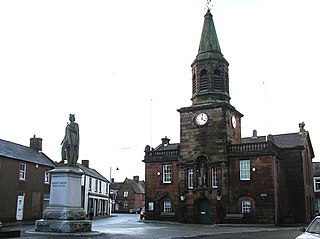
Dumfries is a market town and former royal burgh in Dumfries and Galloway, Scotland, near the mouth of the River Nith on the Solway Firth, 25 miles (40 km) from the Anglo-Scottish border. Dumfries is the county town of the historic county of Dumfriesshire.

Dumfries and Galloway is one of the 32 unitary council areas of Scotland, located in the western part of the Southern Uplands. It is bordered by East Ayrshire, South Ayrshire, and South Lanarkshire to the north; Scottish Borders to the north-east; the English ceremonial county of Cumbria, the Solway Firth, and the Irish Sea to the south, and the North Channel to the west. The administrative centre and largest settlement is the town of Dumfries. The second largest town is Stranraer, located 76 miles (122 km) to the west of Dumfries on the North Channel coast.

Airdrie Savings Bank was a small commercial bank operation in the Lanarkshire area of Scotland. It ran three branches throughout the area, with its head office in Airdrie at the time of the announcement of its closure. Total assets of the bank at 31 October 2013 were £158 million with a reported loss of £267,000. In January 2017, the bank announced it would begin closure proceedings on 28 April of that year.

Dumfriesshire or the County of Dumfries or Shire of Dumfries is a historic county and registration county in southern Scotland. The Dumfries lieutenancy area covers a similar area to the historic county.
David of Scotland was a Scottish prince and Earl of Huntingdon. He was the grandson of David I and the younger brother of two Scottish kings, Malcolm the Maiden and William the Lion.

Henry Duncan FRSE was a Scottish minister, geologist and social reformer. The minister of Ruthwell in Dumfriesshire, he founded the world's first mutual savings bank that would eventually form part of the Trustee Savings Bank. He served as Moderator of the General Assembly of the Church of Scotland in 1839. At the Disruption has left the Church of Scotland and sided with the Free Church. He was also a publisher, a philanthropist and an author, writing novels as well as works of science and religion.

Robert Murray M'Cheyne was a minister in the Church of Scotland from 1835 to 1843. He was born at Edinburgh on 21 May 1813, was educated at the university and at the Divinity Hall of his native city, and was assistant at Larbert and Dunipace. A mission of inquiry among the Jews throughout Europe and in Palestine, and a religious revival at his church in Dundee, made him feel that he was being called to evangelistic rather than to pastoral work, but before he could carry out his plans he died, on 25 March 1843. McCheyne, though wielding remarkable influence in his lifetime, was still more powerful afterwards, through his Memoirs and Remains, edited by Andrew Bonar, which ran into far over a hundred English editions. Some of his hymns became well known and his Bible reading plan is still in common use.

Annan is a town and former royal burgh in Dumfries and Galloway, south-west Scotland. Historically part of Dumfriesshire, its public buildings include Annan Academy, of which the writer Thomas Carlyle was a pupil, and a Georgian building now known as "Bridge House". Annan also features a Historic Resources Centre. In Port Street, some of the windows remain blocked up to avoid paying the window tax.

The Ruthwell Cross is a stone Anglo-Saxon cross probably dating from the 8th century, when the village of Ruthwell, now in Scotland, was part of the Anglo-Saxon Kingdom of Northumbria.

Lochmaben is a small town and civil parish in Scotland, and site of a castle. It lies 4 miles (6 km) west of Lockerbie, in Dumfries and Galloway. By the 12th century the Bruce family had become the local landowners and, in the 14th century, Edward I rebuilt Lochmaben Castle. It was subsequently taken by Archibald Douglas, 3rd Earl of Douglas in 1384/5 and was abandoned in the early 17th century. The town itself became a Royal Burgh in 1447.

Clan Johnstone is a Border Reiver Scottish clan.

Newton Wamphray is a village in Dumfries and Galloway. Wamphray is the name of the surrounding parish and of the Wamphray Water, which flows south-west through the Wamphray Glen to join the River Annan near the small village, or hamlet, of Newton.
Canonbie is a small village in Dumfriesshire within the local authority area of Dumfries and Galloway in Scotland, 6 miles south of Langholm and 2 miles north of the Anglo-Scottish border. It is on the A7 road from Carlisle to Edinburgh, and the River Esk flows through it. There are frequent references in older documents to it as Canobie.

Brow is a hamlet on the B725 lying around 3 km from Ruthwell in the Parish of that name on the Solway Firth between Dumfries and Annan in Dumfries and Galloway, Scotland. The Raffles Burn runs through the site, marked on maps as the Brow Burn it flows into the Solway Firth at Lochar Bay.
Events from the year 1836 in Scotland.
The Dumfries Courier is a weekly newspaper published in Annan, Scotland. It was founded in 1809 by Rev. Dr Henry Duncan (1774-1846) as The Dumfries and Galloway Courier and is currently published by the DNG Media Group as the Dumfries Courier.
Events from the year 1809 in Scotland.
The Murrays of Cockpool were a minor noble Scottish family who were seated originally at Cockpool Castle, Dumfries and Galloway, Scotland. They moved to Comlongon Castle in the 15th century.
Ruthwell Savings Bank, the first of its kind, was formed in Ruthwell in 1810, by the Rev. Henry Duncan. Although a pioneer in savings bank history, the Ruthwell achieved limited commercial success and was taken over by the Annan Savings Bank in 1875.















